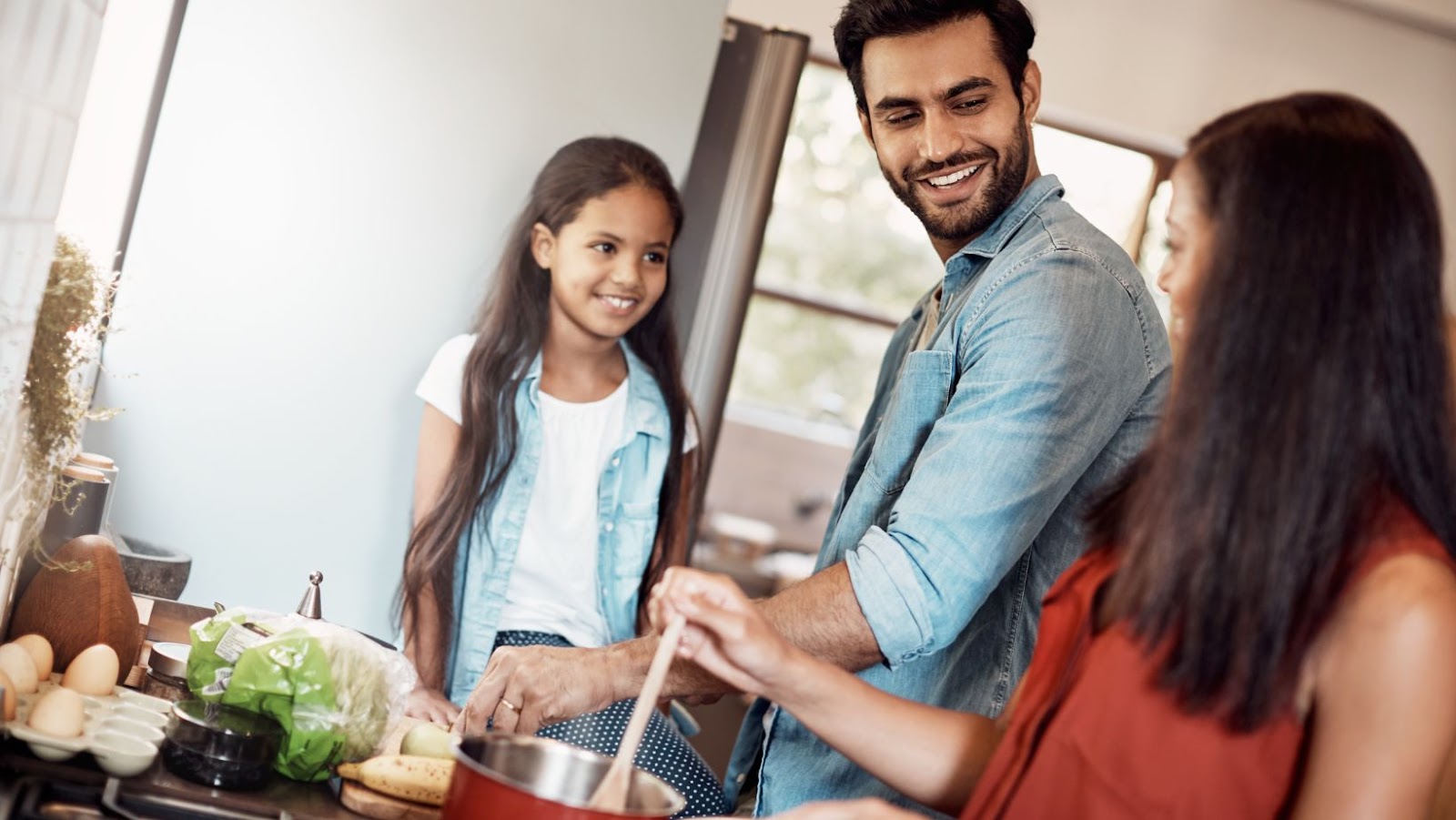Becoming a better cook requires more than just following recipes; it involves a combination of practice and experimentation to develop a sense of creativity, intuition, and confidence in the kitchen.
Here are some tips to help you become a better cook:
| Tip | Description |
| Practice | Cooking is a skill that improves with practice. Try cooking different dishes and techniques regularly to build your confidence. |
| Experiment | Don’t be afraid to experiment with new ingredients, cooking methods, and flavour combinations. Play around with spices and herbs to create new flavours. |
| Learn | Watch cooking shows, read food blogs and cookbooks, and take cooking classes to expand your knowledge and skills. |
| Use the right tools | Invest in quality cookware, knives, and other kitchen tools to make cooking easier and more enjoyable. |
| Get feedback | Ask for feedback from others on your cooking and be open to constructive criticism. |
Practice, experiment, learn, use the right tools, and get feedback to become a better cook and unleash your creativity in the kitchen.
Mastering Basic Cooking Techniques
Mastering basic cooking techniques can be the key to becoming a better cook. Whether you want to become a chef or just an amazing home cook, mastering some of the basic cooking techniques like sautéing, blanching, braising and roasting can help you take your cooking to the next level.
In this article, we will explore the various techniques and methods to becoming a better cook through practice and experimentation.
Appeasing A Food Geek A Blog Dedicated to the Magic Behind Fantastic Recipes
Understanding different heat sources and their applications is a crucial aspect of mastering basic cooking techniques and becoming a better cook.
| 1. Gas stove: | This is one of the most popular heat sources in kitchens. Gas stoves provide instant heat and precise temperature control. They are a great option for cooking anything from eggs to stir-fry dishes. |
| 2. Electric stove: | Electric stoves, also known as induction stoves, are becoming increasingly popular. They are more energy-efficient than gas stoves and provide even heating. They are suitable for cooking a wide range of dishes, including soups and stews. |
| 3. Oven: | Ovens are used for cooking, baking, and roasting. They can be powered by gas or electricity and come in different sizes and types. Ovens are ideal for baking cakes, roasting meats and vegetables, and toasting bread. |
| 4. Grill: | Grilling is a cooking technique that involves cooking food over an open flame or heat source. Grilling can be done on a gas or charcoal grill, and is perfect for cooking meat, vegetables, and even fruit. |
Understanding these heat sources and their applications will allow you to cook your favourite dishes to perfection. So, start experimenting with different heat sources and become a better cook.
Knife skills: how to chop, dice and slice effectively
Mastering basic knife skills is a crucial step towards becoming a better cook as it not only saves time but also ensures safety while working in the kitchen. Here are simple instructions for three of the most commonly used cutting techniques:
| Chopping: | Hold the handle and rest the blade on the cutting board at an angle. Bring the blade down and forward through the food in a rocking motion, repeating as necessary until you achieve the desired size of chopped pieces. |
| Dicing: | Start by chopping the food into long pieces. Stack them and cut into thin slices or planks. Turn the slices and cut across to create small cubes. |
| Slicing: | Hold the food with your non-dominant hand and use your dominant hand to slice through the food in a controlled and steady back-and-forth motion. |
Remember to keep your knife sharp and practice safety, including keeping your fingers out of the way, placing a damp towel or non slip mat under your cutting board, and never leaving your knife unattended. With practice and experimentation, you can become confident in your knife skills and excel in the kitchen.
Pro tip: Once finished using your knife, wash and dry it immediately, storing it in a block or on a magnetic rack to avoid any risk of accidents while reaching for it.
Cooking techniques: boiling, sautéing, roasting, grilling, and broiling
Cooking techniques such as boiling, sautéing, roasting, grilling, and broiling are fundamental skills that every aspiring cook should master. By learning these techniques, you can elevate your cooking game and create a range of delicious meals.
Here’s a breakdown of each technique:
| Technique | Description |
| Boiling | This involves cooking food in boiling water at 100°C. It’s great for cooking pasta, vegetables, and proteins like eggs and chicken. |
| Sautéeing | This involves cooking food in a shallow, hot pan with a small amount of oil or butter. It’s great for cooking vegetables, meat, and seafood quickly. |
| Roasting | This involves cooking food in an oven with dry heat. It’s great for cooking vegetables, meat, and poultry. |
| Grilling | This involves cooking food over an open flame or a hot grill plate. It’s great for cooking meat, poultry, fish, and vegetables, and adds a smoky flavour to your food. |
| Broiling | This involves cooking food under a direct heat source, usually in an oven. It’s great for cooking foods like steak, chicken, and fish with a crispy outer layer. |
By practising and experimenting with these techniques, you can become a better cook and elevate any dish that you make.
Pro Tip: Don’t be afraid to try new things in the kitchen. Experimentation leads to discovery and can unlock your full culinary potential.

Experimenting With Flavors and Ingredients
When it comes to becoming a better cook, it is important to experiment with flavours and ingredients. By trying out different flavour combinations and utilising different ingredients, you can create recipes that are both delicious and unique. Practising your cooking techniques is another way to increase your culinary confidence and skill set.
In this article, we will take a look at the benefits of experimentation and practice when it comes to becoming a better cook.
Building a comprehensive spice rack
A comprehensive spice rack is essential for any home cook looking to experiment with flavours and ingredients and become a better cook through practice and experimentation.
The following tips can help you build an extensive spice collection:
- Start with the basics: Salt, pepper, cinnamon, and paprika are a few of the essential spices every cook needs in their collection.
- Expand your collection: Experiment with new spices such as cumin, nutmeg, allspice, and coriander. Try to find different varieties of spices such as smoked paprika or chipotle chilli flakes.
- Store your spices properly: Most spices should be stored in airtight containers away from heat and light.
- Organise your spice rack: Organising your spices alphabetically, by cuisine, or by colour can make it easier to find the spices you need while cooking.
Pro Tip – Smelling the spice can help you determine the freshness of the spice. If the smell is strong, the spice is fresh; if it is weak, the spice may have lost its potency.
Incorporating new flavours and ingredients into basic recipes
If you’re bored of the same old recipes and want to add more flavour to your cooking, experimenting with new flavours and ingredients can take your dishes to the next level.
Here are some tips to get started:
| Start with basic recipes you know and love, and try adding new herbs, spices or seasonings to elevate the flavours. |
| Expand your culinary repertoire by exploring international cuisines and trying new ingredients like miso paste, tahini, or lemongrass. |
| Embrace the seasons and experiment with locally sourced produce. |
| Don’t be afraid of making mistakes – cooking is all about trial and error. |
| Take note of your experiments and use what you’ve learned to make more refined dishes in the future. |
| With time, practice and experimentation, you’ll become a more confident cook and a flavour master. |
Learning how to balance sweet, sour, salty, and umami flavours
One of the essential skills in being a better cook is learning how to balance sweet, sour, salty, and umami flavours in your dishes. To become proficient in this skill, you need to practise and experiment with different ingredients and flavours.
Here are the tips to follow:
- Start with a basic recipe and experiment by adding a little bit of a sweet, sour, salty, or umami ingredient to it. For example, adding soy sauce to a soup or a few drops of lemon juice to a sauce.
- Taste as you go and make adjustments to the ratio of ingredients to achieve the desired flavour profile.
- Keep a variety of pantry staples, such as vinegars, oils, and spices, on hand to enhance and balance flavours.
- Pay attention to the flavours in your dishes and how they complement or contrast each other. This will help you develop your palate and create more complex and nuanced dishes over time.
Adapting to Different Cooking Styles and Cultures
Experiencing and experimenting with different cooking styles and cultures can be a great way to become a better cook. Learning different culinary techniques, as well as flavour combinations from different cultures, can inspire and improve your own cooking style. Additionally, adapting to different cooking styles and cultures can help you become more versatile, allowing you to create dishes that combine some of your favourite flavours.
Let’s take a look at how you can use practice and experimentation to become a better cook.
Understanding different cooking styles and cuisines
Understanding different cooking styles and cuisines is essential for adapting to new flavours and cultures. By becoming more familiar with various cooking techniques and cultural dishes, you can become a better cook through practice and experimentation.
Here are a few tips to help you get started:
| Tip | Description |
| 1 | Familiarise yourself with different spices and seasonings commonly used in different cuisines. |
| 2 | Experiment with different cooking techniques such as braising, grilling, and frying to add variety to your dishes. |
| 3 | Try out new recipes and be open to making adjustments to suit your taste preferences. |
| 4 | Embrace cultural differences and learn about the history and traditions behind different dishes. |
By trying out different cuisines and cooking styles, you can expand your culinary horizons and develop new skills as a home cook!
Pro tip: Don’t be afraid to make mistakes in the kitchen – they can often lead to new discoveries and flavour combinations.
Experimenting with international recipes and ingredients
Trying out international recipes and ingredients is a great way to expand your culinary skills and knowledge, as well as get a taste of different cultures and cooking styles. However, it can be intimidating to step outside your comfort zone and experiment with unfamiliar cuisines. Here are some tips to help you adapt to different cooking styles and cultures and become a better cook through practice and experimentation:
| Research: | Take the time to read recipes and learn more about the ingredients and techniques used in different cuisines. |
| Start small: | Begin by incorporating one or two new ingredients or techniques into your usual recipes before attempting to cook an entire meal from a different cuisine. |
| Get feedback: | Ask friends or family members who are familiar with the cuisine to taste your dishes and provide feedback. |
| Practice, practice, practice: | Don’t be afraid to make mistakes and keep practising until you get the recipe just right. With time and practice, you’ll become more comfortable and confident in the kitchen. |
Pro tip: Keep a journal or recipe book to jot down notes and record your experiences as you experiment with new cuisines and ingredients.
Adjusting recipes to meet dietary restrictions or preferences
As a cook, adjusting recipes to meet dietary restrictions or preferences is an essential skill that can help you accommodate different cooking styles and cultures. Here are some tips for adapting recipes:
| 1. Experiment with alternative ingredients: Instead of using ingredients that might trigger food allergies or intolerances, explore creative alternatives such as almond flour, soy sauce, xanthan gum, or coconut milk. |
| 2. Adjust cooking techniques: When cooking without dairy, for example, you may need to modify your technique to ensure that your dish has the same texture and consistency as one containing dairy. Try using vegetable broth or coconut milk as a substitute. |
| 3. Be mindful of cultural differences: If you’re cooking for someone of a different culture, research their traditional dishes and ingredients to ensure that you’re being respectful of their food culture. |
By practising and experimenting with different recipes and techniques, you’ll become a more versatile cook who can adapt to any dietary need or preference.
Improving Creativity and Resourcefulness in the Kitchen
Becoming a better cook involves more than just following recipes – it requires creativity and resourcefulness. Every cook has a unique style, way of preparing and combining ingredients, and a toolbox of techniques to create meals that their family and friends love. Improving creativity and resourcefulness in the kitchen can yield not only more deliciousness, but also a greater sense of accomplishment.
Let’s explore just how to do that through practice and experimentation.
Learning to improvise and adapt recipes with what’s on hand
Learning to improvise and adapt recipes with what’s on hand is a skill that can greatly enhance your culinary abilities and make you a better cook through practice and experimentation.
Here are some tips to help you build your improvisational cooking skills:
- Start with a basic recipe and use it as a framework to create your own unique version.
- Experiment with different flavour combinations and ingredients to see what works well together.
- Familiarise yourself with flavour profiles and cooking techniques that can help you modify recipes to suit your needs.
- Embrace mistakes and learn from them to improve your improvisational skills.
- With practice, you can become a more resourceful and creative cook who can easily adapt to any situation in the kitchen.
Pro Tip: Keep a well-stocked pantry with versatile ingredients like beans, grains, canned tomatoes, and spices to give you more options for improvising recipes.

Developing a sense of intuition for cooking and flavour pairing
Developing a strong sense of intuition for cooking and flavour pairing can be a game-changer in the kitchen by increasing creativity and resourcefulness. Here are some tips on how to become a better cook through practice and experimentation:
| Start by experimenting with different cuisines and ingredients to expand your palate and flavour profile. |
| Focus on understanding the basics of cooking, like timing, seasoning, and cooking methods, to build a solid foundation for your culinary intuition. |
| Pay attention to aromas, textures, and visual cues when cooking to better understand how different ingredients work together. |
| Trust your instincts and don’t be afraid to make mistakes. Some of the best recipes come from happy accidents and improvisation. |
| Taste everything repeatedly during the cooking process to adjust seasoning and other flavours to get it right. |
| Engage your senses and intuition to create unique flavour pairings and dishes that are a true representation of your style and creativity.
Pro Tip: Keep a journal of your culinary experiments to keep track of what works and what doesn’t work well. |
Using food scraps and leftovers creatively to minimise waste
Using food scraps and leftovers creatively is an excellent way to minimise waste and save money while improving your creativity and resourcefulness in the kitchen.
Here are some tips to help you make the most of your food scraps and leftovers:
| Tip | Action |
| 1. | Use vegetable scraps to make homemade broth or stock. |
| 2. | Cut up vegetable scraps and use them in stir-fries, soups, or stews. |
| 3. | Use stale bread to make croutons, bread pudding, or bread crumbs. |
| 4. | Turn leftover mashed potatoes into potato pancakes. |
| 5. | Use leftover chicken to make chicken salad, chicken tacos, or chicken soup. |
By learning to use your scraps and leftovers creatively, you’ll not only help reduce food waste but also develop your cooking skills and experiment with new flavours and ingredients. So, don’t be afraid to get creative in the kitchen and let your imagination run wild!
Seeking Inspiration and Learning From Others
Cooking is a skill that can be learned through practice and experimentation. To become a better cook, it’s important to seek out inspiration and learn from other chefs. From cookbooks, online recipes, and television cooking shows, there are plenty of techniques and recipes that can be used to help improve your cooking skills.
This section will explore how you can use these sources to become a better cook.
Following cooking blogs, cookbooks and YouTube channels for inspiration
Becoming a better cook takes practice, experimentation, and most importantly, inspiration. Following cooking blogs, cookbooks, and YouTube channels can provide you with an endless source of inspiration and learning opportunities.
Here are a few tips to help you get the most out of cooking resources:
| Choose a few sources that align with your interests and skill level. |
| Don’t be afraid to try cooking techniques or ingredients that are new to you. |
| Take notes and document your cooking experiences to learn from your mistakes and successes. |
| Join online cooking communities to share your experiences and learn from others. |
Remember, becoming a better cook is a journey, not a destination. Keep practising, experimenting, and seeking inspiration to improve your skills in the kitchen.
Attending cooking classes or workshops to learn new skills and techniques
Attending cooking classes or workshops is an excellent way of seeking inspiration and learning new skills and techniques to become a better cook through practice and experimentation. Such classes offer a great opportunity to learn from experienced chefs and interact with other cooking enthusiasts in a fun and relaxed atmosphere.
Here are some benefits of attending cooking classes or workshops:
| – Learn new cooking techniques and skills. |
| – Discover unfamiliar ingredients and their uses. |
| – Gain valuable feedback from expert chefs and other participants. |
| – Get inspired by different cuisines, cultures, and cooking styles. |
| – Meet new people who share similar interests and passions. |
| – Develop confidence in your own cooking abilities and experiment with new recipes. |
Attending cooking classes is an excellent way to improve your cooking skills and explore new aspects of the culinary world through hands-on experience.
Pro tip: Choose classes based on your interests and skill level, take notes, and practise what you learn at home.

Learning from family, friends, and other home cooks for cooking tips and tricks
Learning from family, friends, and other home cooks can be an excellent way to improve your cooking skills and expand your culinary horizons. Here are some tips and tricks to help you get started:
| Reach out to family and friends who are passionate about cooking and ask them for their favourite recipes and cooking techniques. |
| Attend a cooking class or workshop to learn new recipes and techniques from a professional chef. |
| Join an online cooking community to connect with other home cooks and exchange recipes and tips. |
| Experiment with different ingredients and cuisines to expand your culinary knowledge and skills. |
| Practice and fine-tune your cooking techniques to achieve perfect results every time. Remember, cooking is an art, and the best way to improve is through practice and experimentation. |
















